The Ryukin goldfish is popular among goldfish collectors due to its unique, striking appearance and propensity to bag awards in grooming competitions.
Ryukin joins the Oranda and Ranchu as one of the “big three.” At goldfish shows, this trio wins most of the major awards, although Lionheads and Telescopes also do well.
If the Ryukin goldfish has piqued your interest, I urge you to read this article first before you decide on keeping one.
Fancy goldfish varieties like Ryukins have different care requirements than others. Unfortunately, wrong and conflicting information saturates the Internet, which confuses hobbyists.
You can rest assured that this article is made possible by facts and pieces of advice from Ryukin goldfish experts themselves.
Ryukin Goldfish Overview
| Scientific Name | Carassius auratus (no particular scientific name) |
| Size | Small 4.7 cm
Medium 7.1-9 cm Large 9.1-12 Jumbo 12+ cm |
| Life Expectancy | 7 years |
| Temperament | Passive and gregarious |
| Diet | Omnivorous but thrives best in a high-protein diet |
| Tank Size | 25 gallons for each fish |
| Tank Temperature | 28℃ – 30℃ (82.4℉ – 86℉) |
| Water Hardness | 5 – 19 dGH |
Natural Habitat and Origin
Ryukin goldfish evolved from the long-finned Wakin and was brought to Satsuma (Kagoshima Prefecture) from China between 1772 and 1788 through Ryukyu (Okinawa Prefecture). As a result of its introduction through the Ryukyu area, this goldfish has been given the name Ryukin.
It has taken many centuries to develop the fancy goldfish varieties we have today, including the Ryukin goldfish. A Ryukin from a champion line can be worth thousands of dollars due to its rarity.
Ryukin Goldfish Size
Ryukin goldfish are designed for small, (4.7 centimeters), medium (7.1 to 9 centimeters), large (9.1 to 12 centimeters), and jumbo (12 centimeters) categories.
Appearance
Doesn’t the Ryukin goldfish look like a hunchback that swallowed a ping-pong ball? On a serious note, this fancy goldfish was bred to be that way!
The Ryukin goldfish features an egg-shaped body. There is an indentation on the anterior dorsal contour of its head where it joins the body, giving it a prominent dorsal hump.
Ryukins usually have medium- to long tails that are held high; their lobes are narrow, and their fins are similar to those of Fantail goldfish.
Having a single dorsal fin, the other fins come in pairs with rounded extremities. The forked caudal fin has well-spread lobes held high.
Take note; Ryukin goldfish are not equal in terms of aesthetic appeal. If you want the best of Ryukins, consider the genes and bloodline of the fish.
No matter how much you groom your fish, it will not appear as beautiful as the ones you see in competitions if it doesn’t come from high-quality stock.
What Colors Do Ryukins Come In?
Ryukin goldfish are either metallic or calico.
Metallic Ryukins are either self-colored (red, orange, yellow, blue, brown, or black) or varicolored, which can have a similar pattern on each side.
Show-quality Ryukins will exhibit intense coloration and their metallic sheen often extends to the fins.
Calico Ryukins, on the other hand, have a blue background with speckles of violet, red, orange, yellow, brown, and black. The intensity of the colors appears even across the body.
Temperament
As with most goldfish, Ryukins are harmless creatures whose only purpose is to swim… and eat! While Ryukins are fairly social, they can survive on their own in a tank.
Lifespan
Seven years is the maximum lifespan of a Ryukin goldfish. You might come across hobbyists who say pump feeding and higher temperatures will only shorten the lifespan. These statements are true, and even proficient well-established breeders in Asia would agree.
Tank Setup
Ryukin goldfish don’t require a fancy tank, but you need to invest in the proper equipment to achieve and maintain optimum water quality.
Tank Size
It’s funny how many sources across the Internet suggest 10 gallons for a Ryukin. Anyone who says such surely hasn’t kept a Ryukin goldfish before.
Twenty-five gallons is the minimum for one Ryukin goldfish, granting that your fish lives alone in its tank. Double the volume for each goldfish you want to add.
Moreover, consider the height of the tank. Ryukins need a tall tank to ensure the proper development of their dorsal humps.
Plants and Decorations
Ornaments are the least of your concern. Ryukin goldfish will do fine with or without live plants and decorations.
Decorate minimally with smooth stones or ceramic aquarium pots for holding living plants, such as:
- Anubias (Anubias barteri, Anubias coffeefolia, and Anubias congensis)
- Windelove (Microsorum pteropus)
- African fern (Bolbitis heudelotii)
Substrate
Ryukin goldfish are better off in a bare-bottom tank, as it requires less maintenance. But if you don’t mind the additional workload, I suggest fine sand and smooth pebbles.
Equipment
Aside from a freshwater testing kit and cleaning tools, here are some devices you need when keeping a Ryukin goldfish.
Aquarium Filter
A good, reliable aquarium filter is an essential component of any fishkeeping setup. Filters not only provide a clean and healthy environment for fish, but they also provide a home for beneficial bacteria.
For a goldfish tank, I recommend a sump or a canister filter.
In general, canister filters are superior to sump systems, but they are expensive and non-customizable. But if you use high-quality media, a sump will be as efficient as a canister filter.
Thermometer and Heater
A thermometer and heater are necessary even if you live in a tropical country. This combo ensures the temperature remains constant throughout the day. A submersible heater would work best since it remains unexposed during partial water changes.
Tanning Light
Contrary to what you may hear or read from online forums, the Ryukin goldfish needs sunlight. A lack thereof causes the fish to become lethargic and lose its pigmentation.
That’s why in Asia, it is common for breeders and groomers to keep their goldfish tanks outdoors. Consider using a tanning light if you are keeping your fish indoors, especially if the tank is far from a window.
UV Sterilization Pump
Sunlight exposure or the use of tanning light promotes algal growth.
Algae, as long as you keep it under control, can be beneficial to your fish in ways aplenty. For one, it provides your fish shade should you wish to keep its tank outdoors.
On the downside, having algae in your tank is unsightly. If you want to keep your aquarium algae-free, you will need a UV sterilizer.
This device will also get rid of bacteria, Ich, and other free-floating parasites from the tank water.
Water Parameters and Maintenance
Granted that you have obtained a top-grade Ryukin and purchased everything you need, the next priority is to achieve optimum water quality.
Water Hardness and pH
Anywhere between 5 to 19 degrees is the ideal water hardness for the Ryukin goldfish. Likewise, the fish does best at a pH of 5 to 8.
Be sure to perform regular tests to ensure the water parameters don’t go far off from these levels, especially after a large-scale water change.
Water Temperature
It is common knowledge that goldfish can survive frigid waters in ponds and lakes by going into torpor. However, the Ryukin is not your common goldfish.
Ryukins thrive best when kept in warm waters, ideally between 28 to 30 degrees Celsius (82.4 to 86 degrees Fahrenheit.)
Warm water increases metabolism, which is important for fish that eats a lot.
Water Changes
You can perform a daily water change of 30 percent or a weekly 70 to 90 percent water change.
Both methods should be fine. But for beginners, big water changes can be disadvantageous, especially for chloramine-treated tap water.
For that reason, experts prefer doing daily water changes as it provides more stable conditions compared to a weekly interval.
Regardless, ensure the new and old water in the tank have consistent parameters. Otherwise, you’ll risk distressing your fish. The worst-case scenario could be that your fish will die from shock.
If you are pump-feeding your Ryukin for an upcoming competition, replace 40 to 50 percent of the tank water every day.
Always use a water conditioner after each water change. In one easy dose, it will effectively render tap water safe. A water conditioner neutralizes chlorine and chloramines, as well as partially eliminates certain metals, like copper and iron.
What Is Optimum Water Quality?
Optimum water quality means zero ammonia (NH3) and zero nitrogen dioxide (NO2). The nitrate level (NO3) should not exceed 60 ppm.
The water quality is as important as the quality of your fish’s diet, especially in grooming. Your Ryukin goldfish will enjoy eating more if the acidity, hardness, dissolved oxygen, and temperature are all tailored to its needs.
To prevent New Tank Syndrome, use Fritz Aquatics Nitrifying Bacteria. Referred to as “good bacteria,” they break down organic waste within the fish tank and provide natural biological aquarium filtration.
Nitrifying bacteria reduce cycle time, thus you can immediately add your fish to a new tank. You can also use nitrifying bacteria after every large-scale water change, aggressive cleaning, or after medicating your fish.
Ryukin Goldfish Diet
A high-protein diet is what the Ryukin Goldfish needs to thrive and maintain its muscular build.
While live foods should be fine for most breeds, it is best to avoid them unless you are rearing fry.
Live feeding increases the risk of parasitic infections and bacterial diseases. Live foods pollute the water rather easily, especially if your fish will not consume everything right away.
Keep your Ryukin safe and satiated by sticking with high-quality commercial fish feed. I recommend:
- Hikari Saki Premium-Grade Fancy Goldfish Food
- HULX SUPER RED 60 Huge and Colorful Gain
- HULX PROTEIN 60 Muscle and Mass Gain
As you may have noticed, these recommendations are sinking pellets. Floating foods are inadvisable, as they increase the risk of swim bladder disease in goldfish.
For breakfast, feed your Ryukin goldfish with steamed eggs mixed with Mito Fish Premium Probiotics. Probiotics promote appetite and gut health. You can also give your Ryukin dehydrated krill bites as an occasional snack.
How Many Times Should I Feed My Ryukin Goldfish?
Ryukin Goldfish will eat four to five times a day, exclusive of snacks. Make it 10 if you are pump feeding. If feeding your fish this frequently is rather inconvenient, using a fish feeder will be helpful.
Why Do Goldfish Eat a Lot?
As with other goldfish, Ryukins do not have a real stomach. Different parts of the intestines perform the job that a stomach usually would.
This explains why the fish expel more waste than most freshwater species and why you should change the tank water frequently.
Can You Overfeed a Ryukin Goldfish?
Now, here’s a commonly raised question. The short answer is no.
As long as you keep the tank water within the recommended temperature, your Ryukin will be fine. Warm water increases their metabolism.
Pump feeding is in fact essential for juveniles and contenders for an upcoming show. The only time you should minimize feeding is when the climate is cold due to non-stop rains or the winter season.
Also Read: What Do Goldfish Eat?
Ryukin Goldfish Tankmates
Goldfish like Pearlscale, Lionhead, and Ranchu are good companions for Ryukin fish. As long as they have sufficient space to swim and you keep up with their maintenance, you can keep one or two of each species together.
Breeding
As long as you gather the right supplies and have a healthy pair of Ryukins, you’ll find captive breeding an easy feat.
What Is the Difference Between a Male and Female Ryukin Goldfish?
Sexing your Ryukins is as simple as checking their genital papillae. Females have rounder protruding tubes, while male papilla looks less prominent and rather sunken.
Moreover, females appear thicker than males, especially if you look at them from above. Ryukin goldfish are already fertile when they reach five months.
When Will I Know My Ryukin Goldfish Is Ready to Breed?
Females holding eggs will look plumper than usual due to their swelling bellies. As for the males, white tubercles appearing on their undersides indicate their readiness and viability to spawn.
How Do I Set Up a Ryukin Goldfish Breeding Tank?
You can use the same tank you set up for raising fry to breed your fish. If it is larger than 10 gallons, use a small shallow basin instead.
A small tank allows the female to form a bond with her chosen mate. Most importantly, it is more manageable.
Aside from the tank, you will need a nest. You can add Cabomba (Cabomba caroliniana) or Hornwort (Ceratophyllum demersum). If you don’t have any of these floating plants, you can use artificial breeding grass.
The water should sit for 72 hours before introducing your fish. You will also need an airstone.
Things You’ll Need:
- A small tank
- Floating plants or artificial breeding grass
- Water conditioned for at least 3 days
- Airstone
How Do I Breed Ryukin Goldfish?
Breeding Ryukin goldfish is done naturally and manually. Regardless of which method you choose, you should always transfer your fish to a small tank to ensure success.
Place the male inside the breeding tank a day after the female. Leave your fish alone for two days.
A female ready to spawn will have a softened abdomen. Gently press the swollen area with your thumb towards its genital papilla to release the ripe eggs.
Do the same for the male. The ripples created by the airstone will facilitate the movement of sperm, which will result in the mixing of the egg with the sperm.
Once the male stops chasing the female, you can pull them out of the breeding tank. Wait for 24 hours before changing the water.
Is it safe to change the water? Yes! The eggs will adhere to the grass and tank walls.
Be sure to prepare treated water before adding
Treat the new water with methylene blue and let it sit for at least three days before adding it to the tank.
Should I Change the Water in the Fry Tank?
Yes! Perform a 20 percent water change every two weeks after the eggs have hatched.
However, it is advisable to wait 7 to 10 days before your first water change. Waiting this long will ensure the fry have bulked up, so you won’t lose some of them during the process.
What Is the Best Food to Feed Goldfish Fry?
If you are trying to minimize expenses, daphnia is the best food to feed to newly hatched fry. However, if you can afford baby brine shrimp, by all means, do so.
Maintain this diet for 10 to 14 days. From then on, you can feed the fry tubifex. As long as possible, you’ll want to feed these young fish live food.
Alternatively, you can give them homemade steamed eggs mixed with spirulina powder.
All you need is 1 part egg mixed with 1 part water and a teaspoon of spirulina powder. Steam the egg mixture on high heat for two minutes for a runny texture.
High-protein steamed eggs strengthen immunity and improve pigmentation.
Health Risks
The best thing about Ryukins is that they are healthier than other fancy goldfish like Orandas.
I’m not saying Ryukins are invincible to parasitic infections and diseases. Ammonia poisoning, fin rot, Ich, and swim bladder disease are common ailments.
Now, I hear and read many complaints about fancy goldfish dying within the first 30 days after it was bought. This high death rate is often due to New Tank Syndrome, which I mentioned earlier.
I guarantee that if you carefully follow this care guide, especially in regard to the diet and water change, you can head off problems early on.
Read More:
Wrapping Up
If you have an aquarium store in your area specializing in goldfish, you have a high chance of getting a Ryukin goldfish that conforms closely to the standard. Consider the fish’s genes, quality, and bloodline.
If you have obtained a show-quality Ryukin, its beauty will come out naturally if you groom it properly and maintain water quality.
While Ryukin goldfish are more resilient than other fancy goldfish, that doesn’t mean they are less forgiving of novice aquarists’ mistakes.



